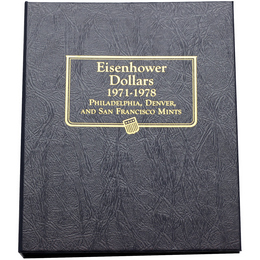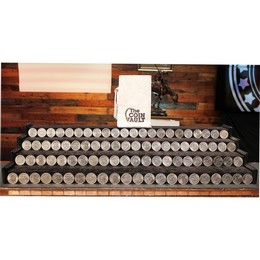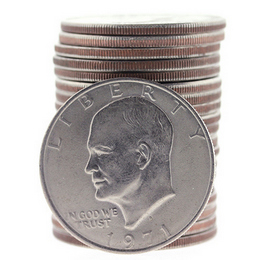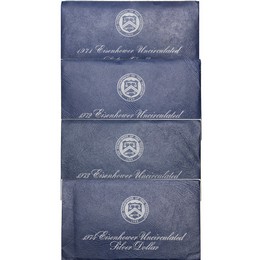Shop Eisenhower Ike Dollar Products

Overview of Eisenhower Dollars
The Eisenhower dollar coin emerged in 1971, marking a notable shift in U.S. coinage after the Peace dollar in 1935. This coin commemorates both President Eisenhower and the Apollo 11 mission, showcasing America's prowess in leadership and space exploration. Produced until 1978, the Eisenhower dollar came in circulation strikes, silver proofs, and uncirculated coins, with contributions from the Philadelphia, Denver, and San Francisco Mints.
Circulation versions were crafted primarily from copper-nickel, while silver proofs and uncirculated coins boasted 40% silver content, appealing to collectors. Measuring 38.1 mm in diameter and weighing 22.68 grams, the Eisenhower dollar coin is larger than previous dollar coins.
Historical Context
President Dwight D. Eisenhower, the 34th President of the United States, served from 1953 to 1961, a period marked by geopolitical tensions and domestic progress. A five-star general in World War II, Eisenhower is remembered for his Cold War leadership, advocating peace through strength while fostering national prosperity. His administration prioritized infrastructure and scientific advancement, paving the way for significant American achievements.
The socio-economic climate during the Eisenhower dollar's inception was defined by post-war recovery and the burgeoning space race. The late 1950s saw economic growth, increased consumerism, and technological innovation. Introduced in 1971, the Eisenhower dollar commemorated national accomplishments, especially in science and technology.
A pivotal event was the 1969 moon landing. The Apollo 11 mission, with astronauts Neil Armstrong and Buzz Aldrin, symbolized U.S. achievement. Although issued later, the Eisenhower dollar coin symbolizes this exploration era. It represents innovation and determination from the 1960s, making it more than currency—a testament to an extraordinary period in American history.
Design Elements
Minted in 1971, the Eisenhower dollar showcases design elements reflecting historical significance and artistic craftsmanship. The obverse features President Eisenhower's profile, honoring his leadership in pivotal moments. 'LIBERTY' and the minting year inscriptions reinforce its patriotic essence.
The reverse is equally compelling, depicting an eagle landing on the moon, inspired by the Apollo 11 mission, a monumental U.S. achievement in space exploration. Surrounding the eagle are 'UNITED STATES OF AMERICA' and 'ONE DOLLAR,' asserting the coin's denomination and national identity.
Notable engraver Frank Gasparro designed both sides, leaving a lasting impression on American coinage with his interpretation of Eisenhower and the lunar eagle. Design variations exist across minting years, such as the 1976 Eisenhower dollar, commemorating the bicentennial with the Liberty Bell over the moon. This special edition highlights how historical events and artistic expression intertwine to create meaningful currency.





